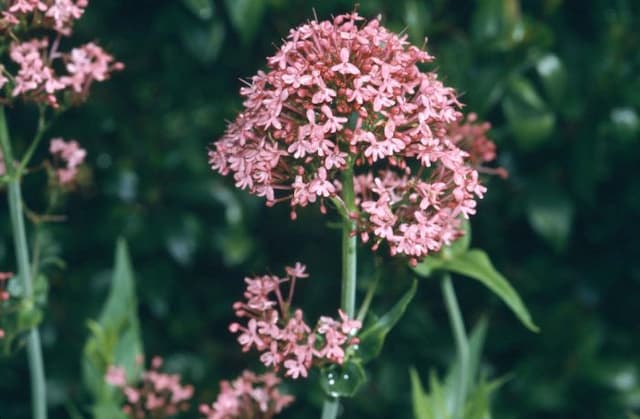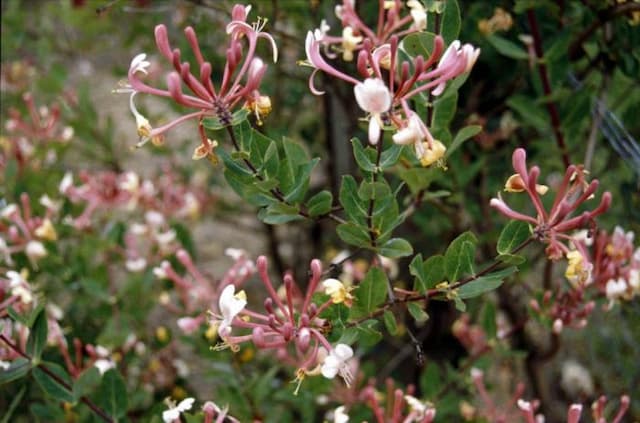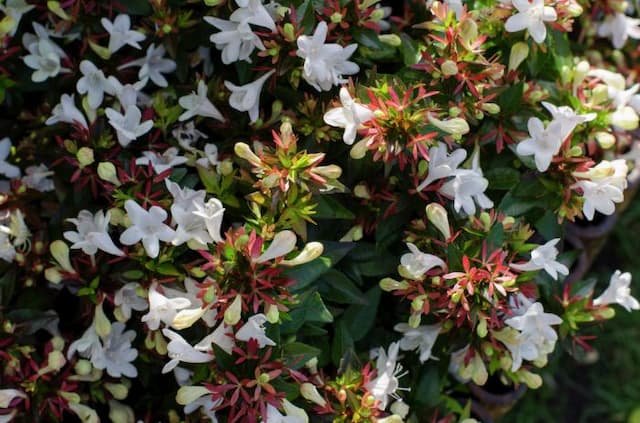Lavender Honeysuckle Lonicera fragrantissima



ABOUT
Lonicera fragrantissima is an evergreen shrub with a rounded shape, growing up to 8 feet tall and 7 feet wide. It has leathery, pointed leaves which are 1–2 inches long and 0.5–0.75 inch wide. In spring, it bears clusters of small, white, fragrant flowers with yellow-tipped petals that are 0.5–0.75 inch in diameter. These cane clusters flowers every year and are often followed by dark purple, edible berries.
About this plant
 Names
NamesFamily
Caprifoliaceae
Synonyms
Winter-flowering honeysuckle, Sweetest honeysuckle, Fragrant honeysuckle, Kiss-me-at-the-gata, Sweet breath of spring, Winter honeysuckle
Common names
Lonicera mamillaris, Lonicera phyllocarpa, Lonicera proterantha, Lonicera pseudoproterantha, Lonicera standishii
 Toxicity
ToxicityTo humans
Lonicera fragrantissima has low toxicity to humans, but ingestion of its leaves may cause minor reactions like nausea and vomiting.
If ingested in large amounts, it may cause irritation of the mouth, throat, and digestive tract. Symptoms may also include headaches, rapid pulse, and confusion. Large doses may lead to severe reactions such as convulsions, coma, and death, so medical attention should be sought immediately.To pets
Lonicera fragrantissima is toxic to animals when ingested. Symptoms of poisoning include vomiting, abdominal pain, rapid breathing, trembling, impaired coordination, and increased salivation. In severe cases, seizures, coma and death may result.
 Characteristics
CharacteristicsLife cycle
Perennials
Foliage type
Deciduous
Color of leaves
Green
Flower color
White
Height
Up to 8 feet
Spread
Up to 7 feet
Plant type
Shrub
Hardiness zones
3
Native area
China
Benefits
 General Benefits
General BenefitsNatural Insect Repellent: The sweet scent of the Lonicera fragrantissima plant has been found to repel certain insects, while providing a natural insect-control in the garden.
Attracts Birds and Butterflies: Lonicera fragrantissima is also known to attract birds and butterflies due to its fragrant blooms.
Provides Privacy: Lonicera fragrantissima can be planted in a hedge to provide privacy for your home or garden.
Fragrant Blooms: The fragrant blooms of the Lonicera fragrantissima are a beautiful part of the garden and will be sure to bring a pleasant scent to the surrounding area.
Hardy Plant: Lonicera fragrantissima is a very hardy plant and can survive most weather conditions. Medical Properties
Medical PropertiesThe plant is very poisonous. Do not use it as a treatment on its own and without consulting a doctor!
Lavender Honeysuckle (Lonicera fragrantissima) is used to treat allergies and reduce inflammation. The flowers are made into a tea that can help with allergies, hay fever, and other the common cold symptoms.
Lavender Honeysuckle is also used to help treat insect bites, wounds, and burns. It's antiseptic and analgesic qualities make it an effective healing agent for skin infections and irritation.
Lavender Honeysuckle has astringent properties that can help shrink swollen tissues and reduce bleeding. This can be helpful in treating issues such as hemorroids.
This plant is also known to have antispasmodic properties which can help reduce muscle spasms, cramps, and constipation.
Lavender Honeysuckle is used to treat anxiety and promote calmness. The fragrant aroma of the plant has a soothing effect on the nerves, leading to relaxation and better sleep.
The essential oils of Lavender Honeysuckle can help reduce the symptoms of bronchitis and certain lung infections.
It has antioxidant properties that can help improve liver and kidney functions. This can help with weight loss, healthy digestion, and improved immunity. Air-purifying Qualities
Air-purifying QualitiesThe Lonicera fragrantissima plant has been shown to naturally purify the air by removing toxins such as benzene, formaldehyde, and toluene. It has also been found to reduce harmful bacterial activity in the atmosphere due to its natural antibacterial properties. Additionally, the plant's sweet aroma has been known to reduce stress, improve sleep, and boost the overall well-being of those living in the space where it is present.
 Other Uses
Other UsesTea Making: The fragrant leaves and flowers of the Lonicera fragrantissima plant can be dried and used to make herbal tea.
Aromatic Decoration: The fragrant blossoms can be used to decorate a room to provide an attractive, pleasant scent.
Fragrance Oils: Dry flowers of the plant can be used to create essential oils with a very sweet, pleasant aroma.
Flavoring: The flowers can be used to add a sweet and fragrant flavor to food and drink.
Wreaths: The fragrant flowers can be used to create wreaths or other decorations, with a pleasant scent in the air when the flowers are burned.
Insect Repellant: The plant is thought to deter certain types of insects, such as mosquitoes, when used as an ingredient in natural insect repellants.
Interesting Facts
 Zodiac Sign Compitability
Zodiac Sign CompitabilityGEMINI
Lonicera fragrantissima is associated with the zodiac sign of Gemini. This zodiac sign is about exploration and adventure, and the sweet scent of the honeysuckle has been said to evoke a feeling of adventure. Gemini is also known for its resourcefulness and creativity, which Lonicera fragrantissima encourages as it is a multi-purpose plant - being able to attract pollinators and being edible, among other things. Thus, the sweet and resourceful Lonicera fragrantissima is a perfect fit for Gemini! Plant Symbolism
Plant SymbolismLonicera fragrantissima is a species of deciduous shrub native to China. Its showy white blooms are incredibly fragrant and often used to symbolize pure, innocent love and joy. The flowers bloom in early winter and often lend a hint of happy and refreshing scent amidst cold bleakness. The rich colors of the Winter Honeysuckle (white against a rich backdrop of green foliage) may also symbolize hope and renewal.
 Water
WaterLonicera fragrantissima should be watered once a week, using a watering can or hose, to ensure that the soil is evenly moistened. It is not necessary to saturate the soil, as too much water can cause root rot.
To prevent over-watering, allow the top layer of soil to dry between waterings. The exact amount of water necessary to keep the plant healthy will vary depending on the climate and growing conditions.
Generally, an inch of water per week should be sufficient. Light
LightThe best light conditions for Lonicera fragrantissima is to place it in an area that gets morning sun, but will be shaded from the hot afternoon sun. An east-facing location is ideal for this plant, as long as it is not in direct sun for too long during the day.
 Temperature
TemperatureThe optimal temperature range for this plant during summer is 65 to 85 degrees Fahrenheit, while during winter the range should stay between 35 and 55 degrees Fahrenheit.
 Pruning
PruningPruning Lonicera fragrantissima is best done in late winter or early spring. Pruning will help keep the shrub healthy and promote a full, bushy growth. The best way to prune is to remove any dead, diseased, or damaged stems, as well as any thick or long stems that are competing for light, blocking pathways, or crowding other shrubs. To encourage a fuller growth, you can also cut back some of the side shoots by approximately one-third. Pruning should be done with sharp shears, making sure to make clean cuts just above a bud or side shoot.
 Soil
SoilFor the best soil mix for Lonicera Fragrantissima, you will need equal parts of composted manure, well-rotted compost, sphagnum peat moss and perlite. The soil’s pH should be between 5.5 and 6.5 to ensure the optimal growth and development of the plant.
 Humidity & Misting
Humidity & MistingThe best humidity conditions for Lonicera fragrantissima are a relative humidity level between 60-70%.
 Suitable locations
Suitable locationsIndoor
Not growing
Outdoor
All year round
Hardiness zone
4 - 8 USDA
 Life cycle
Life cycleThe plant has a spreading habit and grows rapidly, reaching its mature size in just a few years.
In fall, the leaves of Lonicera fragrantissima turn yellow and fall off, leaving bare branches throughout winter. This plant is highly valued for its fragrant flowers, which emit a strong, sweet scent that attracts bees and other pollinators.
Lonicera fragrantissima is easy to grow and maintain, and is often used as a border or screen plant, or as a specimen plant in gardens and parks. It prefers well-drained soil and partial shade, but can also grow in full sun. Pruning is recommended after flowering to encourage bushier growth and remove any dead or damaged branches. Propogation
PropogationPropogation time
March - May
Softwood cuttings:
Fresh cuttings from the current season's growth should be taken in late spring/early summer when the new growth has just started to harden off. Cuttings should be approximately 4-6 inches long and take off all sideshoots and leave the leaves on the cutting. Place the cuttings in a damp medium such as vermiculite at a temperature of around 65-75 degrees Fahrenheit. Keep in a light, airy location and mist several times a day. Roots should appear within 4 to 8 weeks. Other methods of propagation such as semi-hardwood cuttings and layering may be used as well.
 Pests
PestsWhitefly, Thrips, Aphid
 Diseases
DiseasesPowdery mildew, Leaf spot, Honey fungus









